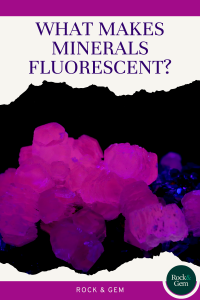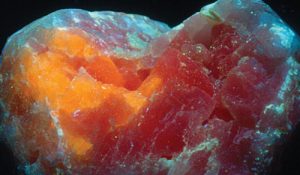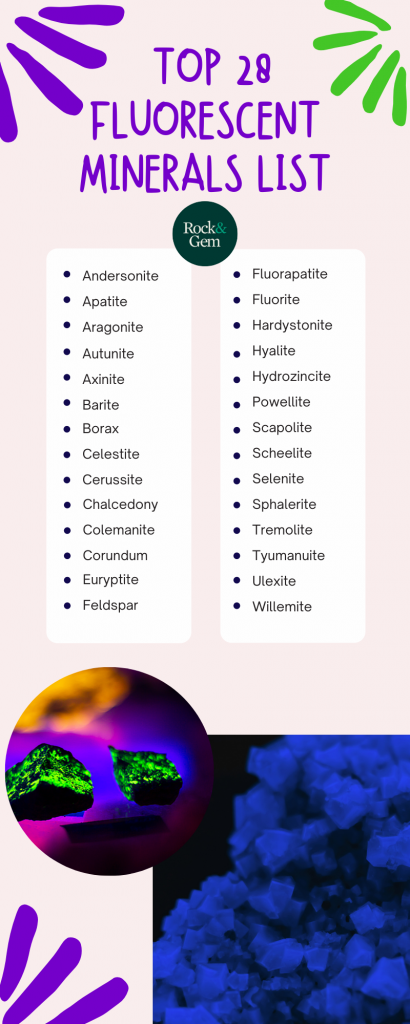
What makes minerals fluorescent? The short answer is that some minerals are self-activators. Others depend on some form of impurity that acts as an activator.
Minerals that are fluorescent under ultraviolet light are beautiful and fun, however, the great majority of minerals do not respond with color under ultraviolet light. Estimates vary from 10 to 15 percent of the known 5,000 minerals may respond. Including the rare earth elements, there are over 30 different common elements and ions that can cause fluorescence.
Self-Activating Minerals
Self-activating minerals use their own electrons to absorb ultraviolet energy giving their electrons the energy to shift away from the atom’s nucleus to the next higher energy level, or orbital. The remaining light energy is out of balance and reemitted and can be seen as a visible color. Ultraviolet energy is not visible so what you see is the lower electromagnetic energy level resulting from the action of the activator.
What Makes Minerals Fluorescent – Activators

The great majority of activators are atoms of certain metal elements which become part of the mineral’s chemistry by taking the place of atoms in the host mineral. For example, sodium chloride halite normally lacks color but if trace manganese atoms are present, they make the halite glow a lovely red under short wave ultraviolet radiation.
When the electrons in a responding mineral shift to a higher orbit they can’t stay there indefinitely. They are constantly shifting with blinding speed between their normal position and a higher orbital as the ultraviolet energy continues. Even though the electrons are shifting, the color we see is steady.
Known Activators
As we gain greater ability to pick apart a mineral, we are finding more activators at work and they are not all metal elements. Some are more complex ions.
Activators like uranyl oxide are regular participants in many radioactive minerals even with the trace manganese. These common activators have joined with some odd elements you would not think could trigger a color such as lead (Pb) in hydrozincite and sulfur (S) in sodalite, a variety of hackmanite from Canada.
What Makes Minerals Fluorescent – Rare Earth Elements

Rare earth elements are common activators. You see these elements listed at the bottom of the Periodic Table because they share many of the same chemical, physical, and mineralogical properties and a similar electron configuration of two valence electrons in an outer orbital.
Since rare earths often occur together in the same deposit, it is inevitable when an activator is present it can be any one of a suite of rare earths rather than just one element.
Two or more rare earth elements have been identified as causing fluorescence in some fluorite, strontianite, calcite, esperite, fluorapatite, powellite and scheelite. These last two are self-activating most often but can also respond to rare earths. The tungstate ion in scheelite is what responds to ultraviolet excitation, usually a brilliant blue under shortwave. In powellite, it is the manganese oxide ion that is the main activator causing a yellow response.
Why Activators Work
There is one other factor worth considering with activators. Why does an activator function only in certain minerals and not in all minerals? There are two reasons. The activator has to have a proper valence or number of electrons in its outer orbital, very often two. Its atoms also have to be close in size to the host atom that it replaces so it becomes part of the mineral’s chemistry and fits in the mineral’s lattice structure.
Manganese
Manganese is the most common activator. It is found in many of the minerals from the Franklin and Sterling Hill mining district in New Jersey causing the town of Franklin to be named the Fluorescent Mineral Capital of the World.

(Jones collection)
Manganese is a transition metal element which means its outer orbital can hold a varying number of electrons, in this case, two-three or four. They can be shared and become the agent in chemical bonding.
Usually, it is manganese valence two that ends up as a trace metal serving as an activator. In the mineral calcite, for example, it has a valence of two and can replace some calcium atoms with a similar valence in the mineral’s lattice structure.
Franklin-Sterling Hill calcite depends on manganese as its activator. The calcite can respond as a brilliant red. Studies have shown the optimum content of manganese activator in calcite at Franklin for a strong fluorescent response is about three percent. Too much of a good thing and the response is diminished, or not there at all.
The same valence two of manganese is also responsible for other fluorescent minerals from the Franklin mine. This is because these are zinc minerals and zinc has a valence of two. How about the size of atoms? Zinc atoms are close enough in size to manganese that they can replace some zinc.
Willemite easily accepts manganese atoms as an activator resulting in a bright fluorescent response but in this case green, not red.
Other minerals using manganese as an activator include pectolite, hardystonite, axinite, esperite, wollastonite and sphalerite. Some of these species also contain other trace metals like rare earth elements.
What Makes Minerals Fluorescent – Other Activators
Other activators are not simple elements. Some minerals may contain a trace of organic material like natural oil and will fluoresce. I recall collecting fluorite that included organics in the quarry at Clay Center, Ohio. The pale brown transparent fluorite cubes had a creamy or slightly bluish color depending on the type of ultraviolet lamp used.
Doubly terminated quartz crystals found in Herkimer, New York, may show fluorescence. “Herkimer Diamonds” developed in cavities created by organic stromatolites which existed millions of years ago. They died and left behind organic material which is picked up by the quartz as it forms. That’s what causes the fluorescence.
Recently Discovered Activators

We now know there is another group of activators not known decades ago consisting of two or three different elemental ions. Such things as carbon trioxide (CO 3 ) in calcite or topaz may cause a response. Much more important in topaz is the activator titanium oxide ion (Ti0 6). California’s official gemstone is benitoite a titanium mineral. It fluoresces a blue short wave thanks to the titanium oxide ion (TiO 3).
Certainly, the most frequently seen ion as an activator is uranyl ion (UO 2). It shows up in a host of radioactive minerals as well as other species.
Quenchers
While it seems that all radioactive minerals should fluoresce, they do not. Uraninite, the main uranium oxide mineral does not respond at all. A host of the popular radioactive minerals, like autunite, do fluoresce. But, the copper uranium mineral torbernite may not. This brings up the idea of quenchers, trace minerals that inhibit or prevent a fluorescent response.
Copper promotes good color in many minerals like azurite and malachite. If copper is present in non-copper species that might otherwise fluoresce, they will not. Copper quenches the fluorescence, but not always.
Normally, adamite is just about colorless but a little copper gives it that rich lime green color. Mexican adamite will fluoresce a bright green color because of the uranyl ion. The fluorescent response varies from brilliant green to no response at all. It all depends on the copper-uranyl relationship controlling the effects of ultraviolet.
Another quencher is iron. But again we find a conundrum. Iron minerals don’t fluoresce. But the iron in trace amounts of a mineral can be an activator as in some feldspars like anorthoclase. It can also be an activator in petalite and pectolite, though they tend to react better with other activators.
Unknown Activators
There are still a great number of minerals that fluoresce because of some unknown activator. A particular mineral species may or may not fluoresce depending on where it is found. This is what makes collecting fluorescent minerals so exciting. Coupled with the wide range of ultraviolet equipment, and the continuing discovery of more mineral species that fluoresce, the hobby will continue to grow.

This story about what makes minerals fluorescent previously appeared in Rock & Gem magazine. Click here to subscribe. Story by Bob Jones.













